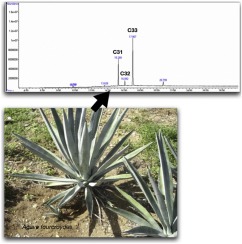Phytochemistry Letters ( IF 1.3 ) Pub Date : 2019-11-02 , DOI: 10.1016/j.phytol.2019.09.013 Kelly M. Monja-Mio , Fabiola Escalante-Erosa , Xochil M. Eb-Puc , Miguel Á. Herrera-Alamillo , Luis M. Peña-Rodríguez , Manuel L. Robert

|
Agaves are cultivated in Mexico as a source of industrial products such as fibers, nutritional supplements and alcoholic beverages. A particularly important trait present in all agaves, which makes them economically viable crops for certain geographic regions, is their ability to grow under water limiting conditions. One of the anatomical characteristics that contributes to this adaptation, is the thick layer of epicuticular waxes deposited on their surface which reduces water loss by evapotranspiration. Still, to date, and in spite of their economic importance, there has been practically no effort to improve the genetics and productivity of agaves; this investigation focuses on the differences in the content and types of the epicuticular waxes present on the surface of leaves of wild and agronomically important Agave species with different ploidy level. The agaves analyzed were two diploids [A. tequilana Weber and the hybrid H11648 (A. amaniensis Trel. & Nowell x A. angustifolia Haw. back crossed to A. amaniensis)]; two pentaploids (A. fourcroydes var. Sac ki and A. fourcroydes var. Yaax ki) and a hexaploid (A. angustifolia var. Chelem ki)
The epicuticular waxes were obtained by hexane extraction and their chemical composition was established by capillary gas chromatography–mass spectrometry (GC/MS). The amount of epicuticular wax varied significantly between the different types (4.40–35.63 μg cm−2), with A. angustifolia var. Chelem Ki (hexaploid) and A. tequilana (diploid) presenting the highest and lowest amounts, respectively. With the exception of A. tequilana, n-alkanes were the main components (63.32–92.13 % of total wax) in the epicuticular wax, with hentriacontane (C31) and tritriacontane (C33) as main compounds. Alternatively, in A. tequilana two aliphatic alcohols were the main components of the wax. These results suggest a correlation between the total epicuticular wax content, the chemical composition of the wax, the ploidy level and the type of habitat in which they grow. This information contributes to the understanding of the tolerance of agaves to different types of stress.
中文翻译:

野生和农学上重要的龙舌兰物种的表皮蜡分析
龙舌兰在墨西哥种植,作为工业产品的来源,例如纤维,营养补品和酒精饮料。在所有龙舌兰中存在的一个特别重要的特征是,它们在限水条件下具有生长的能力,这使它们在某些地理区域具有经济可行性。有助于这种适应的解剖学特征之一是表皮蜡的厚层沉积在其表面上,这减少了由蒸散作用引起的水分流失。迄今为止,尽管它们具有经济重要性,但实际上仍未进行任何努力来改善龙舌兰的遗传和生产力。这项研究的重点是野生和具有农学意义的龙舌兰叶片表面上表皮蜡的含量和类型的差异。种具有不同的倍性水平。分析的龙舌兰两个二倍体[ A. tequilana Weber和混合H11648(A. amaniensis TREL&诺埃尔X。A.沙枣唧唧回冲过。A. amaniensis)]; 两个五倍体(A. fourcroydes var。Sac ki和A. fourcroydes var。Yaax ki)和六倍体(A. angustifolia var。Chelem ki)
表皮蜡是通过己烷萃取获得的,其化学成分是通过毛细管气相色谱-质谱法(GC / MS)确定的。表皮蜡质的量的不同类型(4.40-35.63微克厘米之间变化显著-2)中,用A.沙枣变种。Chelem Ki(六倍体)和A. tequilana(二倍体)分别代表最高和最低的含量。除龙舌兰之外,正链烷烃是表皮蜡中的主要成分(占蜡总量的63.32–92.13%),主要成分是三金刚烷(C31)和三金刚烷(C33)。或者,在A. tequilana中两种脂族醇是蜡的主要成分。这些结果表明总表皮蜡含量,蜡的化学组成,倍性水平和它们生长的栖息地类型之间存在相关性。这些信息有助于理解龙舌兰对不同类型压力的耐受性。











































 京公网安备 11010802027423号
京公网安备 11010802027423号